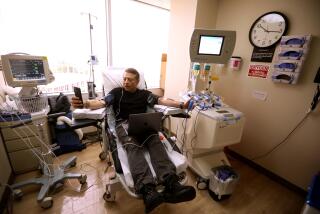COLUMN ONE : Doctoring, Dollars and Sense : Medical technology is a prime suspect in the case of runaway health-care bills. Cost concern is gaining on the ‘spare nothing’ approach to treatment.
- Share via
LOUISVILLE, Ky. — When the federal government in 1984 approved a futuristic shock wave machine that could pulverize kidney stones, doctors nationwide saw new hope that hundreds of thousands of Americans could be helped without surgery.
What Darrell Lewis saw was a gold mine--enormous profits for his employer, Humana Inc., which owns 81 hospitals from California to Florida. “The demographics were great,” said Lewis, who is in charge of assessing new technologies for Humana.
As a preemptive strike against competitors, the hospital chain immediately bought six of the big machines, called lithotripters, at $1.6 million each.
Humana’s rush was understandable. America was in the middle of what one health economist calls “a medical technology arms race” in which few questions were asked about a new technology’s effectiveness or cost.
But no more.
A consensus is emerging that medical technology is a major driving force behind runaway health-care costs, now approaching 12% of the gross national product.
And government regulators, employers, insurers and health care providers are proclaiming an unprecedented resolve to assess emerging medical technologies more closely and to encourage more appropriate use of existing ones--all with an eye on constraining costs.
“Things in the past developed without a whole lot of questions being asked about their efficacy and effect on patient health,” said Wayne I. Roe, a Washington-based health-care consultant. “But the squeeze is on.”
“The issue with medical technology is not necessarily whether it is good or bad,” added Sanford Schwarz, a University of Pennsylvania internist and health economist. “Most technologies are good--under selected circumstances. The challenge is to define the clinical conditions under which a technology is appropriate.”
Yet with few guidelines and little agreement on usage, experts see no sign that doctors or patients are ready to abandon the spare-nothing approach to treatment.
“Even now, I think the old philosophy still prevails, by and large,” Roe said. “If you can make something that works, it’s still very difficult for it not to be developed and used.”
“That’s the basic problem,” Schwarz agreed. “Nobody is willing to control costs when it’s them or their relatives involved. The major component missing right now is a lack of consensus or political will to face what is appropriate medical care.”
Experts say there could be no better time than now to begin performing more rigorous technology assessment. A veritable flood of products is poised to enter the marketplace in the next decade.
“Ideally, technology should lower costs, but it doesn’t,” said Dr. Ralph W. Schaffarzick, retired vice president and medical director of California Blue Shield. “Technologies themselves are usually expensive. And utilization of them is often very great because doctors and the public want access to all the newest things.”
Schaffarzick said a new product seldom replaces an older one. Instead, doctors often use both the new and the old.
For instance, the CT scanner or the magnetic resonance imager may be much more accurate than X-ray at detecting blood clots in the skull, but Schaffarzick said that physicians “more often than not” use all three. The expenses mount quickly--up to $500 for each use of a CT scanner, $900 for a magnetic resonance image and $60 for an X-ray.
“Some doctors still are not confident with the newer technologies,” he said. “And there’s always the lurking fear of malpractice--or at least, the excuse of it.”
Unquestionably, technology has done much to prolong lives and improve the quality of life.
Yet as Americans live longer, their changing medical needs are dictating more and newer types of treatments, especially for the afflictions of aging. For instance, a person today with heart disease might live long enough, thanks to new medications, to develop Alzheimer’s Disease or other ailments.
“It’s going to cost more per capita. No question,” said William McGiveny, director of the American Medical Assn.’s division of health care technology.
A 20-Year Boom
In addition to brain scans and magnetic resonance imaging, the 20-year boom in medical technology has ushered in devices such as the heart pacemaker, dialysis and a machine that could temporarily take over the functions of the heart during bypass surgery. Those decades also saw a whole generation of new heart drugs and countless biotechnology-based diagnostic and monitoring devices.
“We had a major explosion in innovations,” recalled Roe, president of Health Technology Associates.
“But these things were being turned loose without adequate assessment,” Schaffarzick said.
During much of that time, the health-care financing system was “rich and overwhelmingly passive,” Roe added. “And physicians got used to having lots of new tools. Their income went up every time they got a new tool, so all the financial barriers either broke down or weren’t there in the first place.”
“What the ‘90s portend,” he said, “are questions, like: Is this surgical procedure of any value versus some medical alternative? Is this new way of monitoring the heart or the blood gases with an invasive, continuous sensor any better than the old way of doing it? Everybody should be asking these questions.”
Among those developing standards and guidelines on efficacy and appropriate use of technology are the influential Blue Cross-Blue Shield Assn. and the federal government’s Health Care Financing Administration.
“It’s everyone’s responsibility to look closely at what we are spending money on,” said Susan Gleeson, executive director of technology management for Blue Cross-Blue Shield.
The precise extent to which technology is responsible for the rise in medical care costs is unknown. Some estimates put it as high as 50% if “hidden” costs are taken into account.
“There is a general consensus that it’s a significant contributor,” said Schwarz, who was the first director of the American College of Physicians’ Clinical Efficacy Assessment Project and now heads Penn’s Leonard Davis Institute of Health Economics.
One dissenter is Dale A. Rublee, a senior AMA policy analyst. “I think technology gets a bad rap in being the scapegoat,” he said. “We don’t know why health care costs are rising. Technology is far and away for the good of society.”
Limiting Coverage
One way to ensure more appropriate use of technology, experts say, is to adopt a policy of “selective coverage.” That was the approach of California Blue Shield when it said it would cover a heart transplant only if it was performed at Stanford University or some other institution with a record of success in such surgery.
“More and more, this will happen,” predicted John R. Ball, medical director of the American College of Physicians, which has been a pioneering proponent of rigorous technology assessment.
Schaffarzick called selective coverage a form of health-care rationing that made sense. He said that the current situation--37 million Americans without insurance and 50 million more who are under-insured--is an “unspoken rationing that puts so many people at risk.”
“What people need to understand is what kind of rationing is best,” Ball said. “We already do it now. We can’t hide that fact.”
The new-found resolve to manage the proliferation of new medical technologies comes at a propitious time, experts say. The 1990s will witness another explosion of advances, such as the use of lasers to sculpt the corneas of near-sighted people or the ability to identify defective genes in an unfertilized human egg.
“The big issue will be how to pay for these new technologies,” said Mark Brand of Amgen Inc., a Thousand Oaks, Calif., biotechnology firm.
Roe cited the example of miniature sensors that will soon be available to monitor the bloodstream.
“But before these devices, which can be pretty expensive, get to the marketplace,” Roe said, “somebody’s got to ask: What good is it going to be to have a $2,000 sensor living inside someone? I think there will be more delays of new things getting to the marketplace.”
Beyond attempting to weed out emerging technologies that may be superfluous or exorbitantly expensive, health planners say, many technologies in current use also need to be assessed.
That also goes for the seemingly endless new uses being found for existing technologies. A classic example of that is the kidney lithotripter, which became the rage in the mid-1980s at Humana and elsewhere.
U.S. hospitals and physician partnerships bought about 250 lithotripters. As the number of patients making use of the machines leveled off to about 125,000 annually, lithotripter owners began looking for other uses for their expensive machines.
Soon they focused on the 1 million Americans who each year experience painful attacks from lumps of cholesterol that form in the gallbladder and block the bile ducts that connect the liver to the digestive tract.
The prospect of using shock waves to break up gallstones was indeed appealing. About 600,000 Americans each year have their gallbladders removed, at a cost of more than $6 billion a year. If the shock wave technique worked, it would be cheaper, faster and less painful than surgery.
But studies from clinical trials now suggest that lithotripters worked for only 10% to 25% of gallstone patients. The treatments also caused disturbing side effects, including blood in the urine and high blood pressure. Late last year, a Food and Drug Administration advisory panel refused to approve the technology for gallstone treatment.
Since then, doctors have developed an experimental way of removing the gallbladder via a combination of other technologies--the laparoscope and the laser.
In-Body Photography
Laparoscopy, used widely by gynecologists and knee surgeons, involves the use of a miniature camera attached at the end of a tube that is inserted through a small incision into the body, where it sends images back to a video screen. It enables physicians to use a laser to detach the gallbladder from the liver and remove it.
If the technique pans out, it would allow for a speedier recovery than conventional surgery, according to its leading proponent, Dr. Christopher J. Daly of Pittsburgh. Such an operation would cost about $1,350--roughly half that of a conventional gallbladder removal. He predicted in the January issue of the newsletter “Health Technology Trends” that perhaps 85% of gallstone patients can be treated with the new procedure.
And as more physicians become trained in laparoscopy, Daly predicted, hospital administrators and technology assessors can expect a rush of new demands from the medical staff for lasers and laparoscopes.
But such requests would have to pass a new test, said Louis B. Hays, recent acting administrator of the Health Care Financing Administration, which sets Medicare payment policies.
“The question will be whether a procedure should be used at all,” he said. “We’re getting more and more into the question of effectiveness. That’s an idea whose time has really come.”
No one thinks it will be easy to gain public support for containing the march of medical technology.
“What we need is for the whole society, not just doctors, to be re-educated in terms of expectations,” said Ball, who is also executive vice president of the American College of Physicians. “Technology is often not necessary or even medically appropriate, but it’s very difficult, because there is a cultural expectation of the application of technology. That’s the American Way.”
“Americans want more medical innovation,” Roe said. “We’re a rich society, but we’re growing older. Health care and health-care technology are the kinds of good that you want to spend more on rather than less. The issue is, let’s spend it well.”
More to Read
Inside the business of entertainment
The Wide Shot brings you news, analysis and insights on everything from streaming wars to production — and what it all means for the future.
You may occasionally receive promotional content from the Los Angeles Times.










